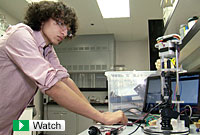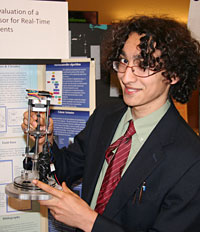You are here
Intern Probes the Depths of Nitrate
04/13/10 Beaverton, Ore.  Watch interview with Avilash CramerApril showers may bring May flowers but it also brings runoff of agricultural fertilizers into rivers and estuaries. In Portland, Oregon, the rain also stresses the sewer system and may cause overflow of sewage into the waterways. This anthropogenic pollution includes inorganic nitrogen (nitrate, NO3-) and can cause eutrophication in an ecosystem.
Watch interview with Avilash CramerApril showers may bring May flowers but it also brings runoff of agricultural fertilizers into rivers and estuaries. In Portland, Oregon, the rain also stresses the sewer system and may cause overflow of sewage into the waterways. This anthropogenic pollution includes inorganic nitrogen (nitrate, NO3-) and can cause eutrophication in an ecosystem.
While there are sensors available that measure the concentration of nitrate in water, they are not meant to measure it as a function of depth in sediment. Yet an ingenious high school student and former Center for Coastal Margin Observation & Prediction (CMOP) summer intern has come up with a new low-profile nitrate sensor that can do just that.
Avilash Cramer engineered a sensor that utilizes an ion-selective electrode (ISE) capable of measuring nitrate concentrations as a function of depth in sediments. And it works in real-time under field conditions.
Gathering sediment samples has its challenges: some areas at the bottom of a river or estuary can be hard to reach; the sediment may be disturbed when taking samples; and one can affect samples by transporting them to the lab for analysis.
Cramer’s device can be lowered into the water and take nitrate measurements in situ. “Temporal data on nitrate accumulation in sediments are preserved because the sensor samples at discrete depths and leaves the sediment profile undisturbed,” Cramer says.
He worked on the research project at CMOP during his high school summer apprenticeship in 2009. The Apprenticeships in Science and Engineering (ASE) Program is a special program of Saturday Academy. CMOP participates in ASE to provide opportunities for students to learn in an interdisciplinary research environment.
The idea behind Cramer’s project grew out of a collaborative effort between two CMOP investigators with very different research interests. Paul Tratnyek, Ph.D. examines the fate of contaminants and other chemicals in the environment, and Holly Simon, Ph.D. is involved in understanding how microorganisms contribute to ecosystem functioning.
“Avi's project provided an intersection between our research areas,” Simon says. “By measuring chemical microenvironments in sediments, we can build a better understanding of how microbial processes relate to chemistry in the environment." Tratnyek’s senior researcher, Jim Nurmi, Ph.D., was Cramer’s frontline mentor and provided guidance with the research project.
They tested and calibrated the sensor using solutions with known concentrations of potassium nitrate. The results indicated the sensor was capable of measuring nitrate at low concentrations.
To field test the device, they traveled to Longview, Washington to take samples in the Columbia River. The results were promising. The sensor was able to record data on nitrate levels in situ in river sediment.  Avilash Cramer demonstrates his nitrate sensor at Intel Northwest Science Expo. Photo courtesy of Jim Nurmi.
Avilash Cramer demonstrates his nitrate sensor at Intel Northwest Science Expo. Photo courtesy of Jim Nurmi.
As the summer internship came to a close, the story might end there. But Cramer wasn’t ready to stop working on his research project. Nurmi agreed to continue mentoring him and helped set up a wet lab in the Cramer family garage. There, in his spare time, he proceeded to engineer a waterproof capsule and install a linear actuator that would move the nitrate sensor in millimeter-scale intervals.
Cramer recently presented the results of his project at the Intel Northwest Science Expo, held on April 2, 2010 at Portland State University. He won the physical sciences Best of Fair for his poster titled “Design, Fabrication, and Evaluation of a Deployable In-Situ Nitrate Sensor for Real-Time Analysis of Sediments.” He also won first place for engineering, most innovative engineering project and a US Army award.
He will travel to San Jose, California in May to compete at the Intel International Science and Engineering Fair (ISEF), the world largest pre-college science competition. Since nitrate-polluted runoff is a continual and growing problem in rivers and estuaries,
Cramer’s sensor may one day provide scientists another tool for studying both anthropogenic pollution and the global nitrogen cycle in ecosystems.
Written by Jeff Schilling
### UPDATE
May 5, 2010 - Cramer won a Gold Medal in the Senior Engineering Category at the international I-SWEEEP Olympiad that took place on May 1-5 in Houston.
May 14, 2010 - Cramer won Intel's environmental management category with his project at this years Intel International Science and Engineering Fair held in San Jose, California.






